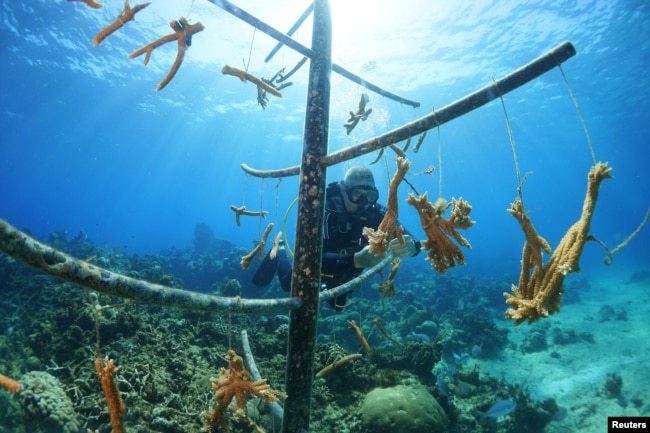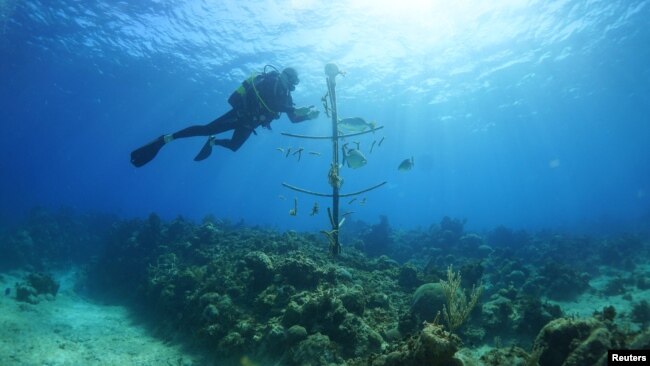世界のサンゴ礁を守ろう!!
希望が持てる明るい記事に、心がやすらぎます。
海が再生しないと、魚も再生しない。
もう一度、この地球の恵と偉大さに感謝を捧げます。
個人レベルで出来ることを実践していきましょう!!
VOAで英語を学びましょう!!
限られた支援でサンゴを育て、サンゴ礁を再生するキューバの人々 (和訳)
Cubans Grow Corals, Restore Reef with Limited Support
May 08,2022
キューバのダイビングインストラクターたちが、珊瑚を育てて植え替えるプロジェクトを始めました。ダイバーたちは、キューバのバリアリーフの一部を復元することを望んでいます。限られた資金で、海岸から回収した資材を使っての作業です。
ルイス・ムイーニョさんは、このプロジェクトのリーダーの一人です。44歳の漁師である彼は、キューバ北部の海岸で育ちました。彼は、マタンサス港の河口の外側にある大好きな珊瑚礁が、何年もかけて徐々に弱まり、魚の数が減っていくのを見てきたと言います。
ムイーニョさんはロイターに対し、「この30年間でサンゴが失われたのは信じられないことだ 。」と語りました。さらに、「私たちの夢は、バリアリーフの珊瑚が失われた部分に再び珊瑚を繁殖させることです。」と話します。
そのためにムイノさんは、キューバ国立水族館とキューバの環境プログラムEcovalor(エコバロール)の支援を受け、他のダイビングインストラクターや近所の小学生と協力しました。
3年前の大嵐の後、海底に広がったサンゴのかけらを集めはじめました。そして、海岸から回収した釣り糸と古いプラスチックパイプで作った海中の”木”の枝に、サンゴのかけらを吊るしたのです。
ムイノさんによると、破片はすぐに成長すると言います。そして、岩に打ち込んだ釘で取り付けられ、サンゴ礁に”植え替え”られます。1年後には、ほとんどが生き残り、長さ60〜80メートルのバリアリーフの一部を再生させるのに十分な大きさに成長するそうです。
「このプロジェクトは時間がかかるんです」と同僚のミッシェル・ソトさんは言います。資金援助も少なく、設備も限られたキューバでのプロジェクトだが、期待以上の成果を上げていると彼は言います。「何事も困難はつきものですが、私たちは前進を続けています......」とコメントしました。
世界中の多くのサンゴ礁と同様に、キューバのサンゴ礁も水温の変化、外来動植物、汚染、乱獲によって危機にさらされています。米国海洋大気庁(NOAA)によると、世界ではすでにサンゴ礁の30〜50%が失われていると言います。
カリーヌ・ギルヴィックさんはフランス人ダイバーで、キューバを初めて訪れたばかります。彼女は、アフリカを含む世界の他の場所のダイビングで見た他のサンゴ礁よりも、このサンゴ礁が良く見えると言います。
「サンゴは......保護されなければなりません」と、最近行ったバラデロ近郊での2回のダイビングの後で彼女は言います。「キューバでは、今あるものを大切にし、観光の影響をあまり受けていないことがわかるのはいいことです。」と彼女は話します。
ムイノさんは、健康なサンゴ礁と幸せな観光客が、彼の本当の報酬だと言います。「私たちはサンゴ礁を愛しているのです」とムイノさんは付け加えました。
Cubans Grow Corals, Restore Reef with Limited Support
A small group of Cuban dive instructors have started a project to grow corals and replant them. The divers hope to restore part of Cuba’s barrier reef. And they are working with limited financial support and using materials recovered from the coast.
Luis Muiño is one of the project’s leaders. The 44-year-old fisherman grew up on Cuba’s north coast. He said he saw his beloved reefs outside the mouth of Matanzas Harbor slowly weaken and the number of fish lessen over the years.
Muiño told Reuters, "It's incredible the loss of coral in the past 30 years." He added, "Our dream is to repopulate again the parts of the barrier reef that have lost their corals."
To make that happen, Muiño worked with other dive instructors and neighborhood schoolchildren with support from Cuba’s National Aquarium and the Cuban environmental program Ecovalor.
They began collecting pieces of coral spread across the ocean floor after large storms three years ago. The pieces were then hung on branches of underwater “trees” made from old plastic pipes and supported by fishing lines recovered from the coast.
Muiño said the pieces grow quickly. They are then “replanted” on the coral reef, attached by nails driven into the rock. In a year, most survive and grow enough to repopulate part of the barrier reef between 60 to 80 meters in length, he said.
"It's a project that takes time," said co-worker Michel Soto. He said the project has done better than expectations even with little financial support and limited equipment in Cuba. He commented, "Everything is difficult, but we keep pushing ahead ... and we are making progress."
Like many coral reefs around the world, the ones in Cuba are threatened by changing water temperatures, invasive plants and animals, pollution and over-fishing. The U.S. National Oceanic and Atmospheric Administration (NOAA) says the world has already lost 30 to 50 percent of its coral reefs.
Karine Guillevic is a French diver who just visited Cuba for the first time. She said the reef looked better than others she had seen on dives elsewhere in the world, including in Africa.
"The coral ...needs to be protected," she said after two dives on a recent trip to nearby Varadero. She said, "It's good to see that in Cuba they take care of what they have, and that it is still not too affected by too much tourism."
Muiño said a healthy reef and a happy tourist are his real reward. "We do this out of love for the reef," Muiño added.
Words in This Story
coral – n. a hard material formed on the bottom of the sea by the skeletons of small creatures
reef – n. a long line of rocks or coral or a high area of sand near the surface of the water in the ocean
incredible – adj. difficult or impossible to believe
tourism – n. a tool with many stiff hairs or fibers that is used for cleaning, smoothing, or painting something

